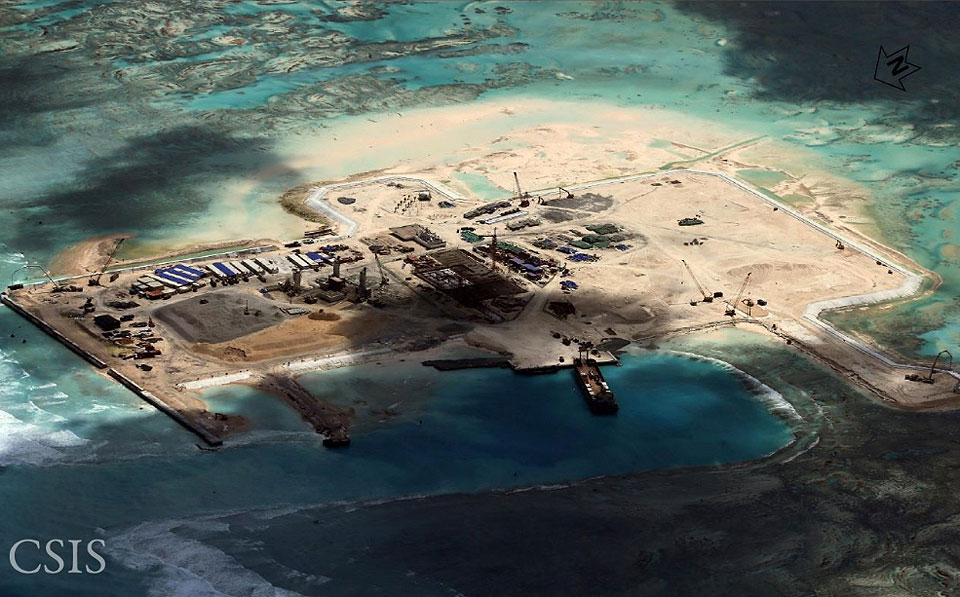China destroyed or damaged over 20,000 acres of coral reef in South China Sea –US think tank

A report published by a Washington-based think-tank alleges that China has caused the most ecological damage in vast areas in the South China Sea through destructive dredging and fishing methods.
Using satellite imagery on 180 occupied and non-occupied features in the South China Sea, the Asia Maritime Transparency Initiative (AMTI) of the Center for Strategic and International Studies (CSIS) found that at least 4,500 acres of coral reefs have been destroyed by China’s artificial island-building in the disputed waters through dredging and landfill. An additional 16,300 acres of coral reefs were damaged due to giant clam harvesting by Chinese fishermen, the American policy group said.
Monica Sato, research associate and lead author of AMTI’s report, “Deep Blue Scars: Environmental Threats to the South China Sea,” said claimants to the South China Sea, primarily China, conduct massive dredging and landfill to fortify structures or outposts in areas they claim in the disputed waters. China claims the South China Sea nearly in its entirety and has ignored and belittled a 2016 international arbitral ruling that invalidated its claim.
Greg Poling, CSIS senior fellow and director of AMTI, said it may take decades for the reefs to come back given the current extent of damage.
Overfishing, he noted, is also a problem as well as the lack of comprehensive fish stock assessment in the region because of the disputes in the South China Sea.
“The only way to stop this is to convince Beijing to stop this. Any effort to physically prevent this is going to be hopeless,” Poling told a press briefing in Manila.
According to Sato, China’s dredging and landfill activities were conducted between 2013 and 2017 using the method of cutter suction dredging.
“A dredger would slice through the reefs and sediments collected is pumped through floating pipelines and then the sediment is deposited in areas through targeted landfills,” Sato said.
GMA News Online has yet to receive a comment from the Chinese Embassy in Manila.
Other South China Sea claimants, such as Vietnam, Malaysia, the Philippines, and Taiwan have also engaged in dredging, but employed methods that are less harmful to the marine ecosystem. The Philippines, Malaysia and Taiwan “barely scratched the surface and contribute to less than 100 acres of destroyed reefs,” Sato said.
“While other states used less detrimental methods, I want to emphasize that any form of dredging is still detrimental to the environment,” Sato said.
Second to China was Vietnam, with 1,500 acres of coral reefs damaged by its activities in the disputed sea.
Sato said Vietnam initially used a less destructive dredging process, but AMTI found out that it started using cutter suction dredgers in 2023.
“It is detrimental and it is still ongoing because Vietnam is building its outpost in the South China Sea. This method is still continuing today,” she said.
AMTI researchers were also alarmed at the fast pace of giant clam harvesting by Chinese fishermen.
Giant clam harvesting became popular in China between 2012 and 2015 because of its resemblance to elephant ivory. International trade and extraction of ivory have been banned globally.
Used in Chinese statuary and jewelry, a single giant clam can be sold for at least USD$100,000, said Sato.
While there is a crackdown on giant clam harvesting and trade by Chinese authorities, Sato said such practice has continued up until 2019.
Poling called for an international coalition led by Southeast Asian claimants “to better survey the damage” and “account for it.”
He also suggested the establishment of joint marine scientific research and fisheries management regimes among claimants and invite China to join.
“China would probably say no but then that further damages China’s credibility because why wouldn’t China want to save coral reefs,” he said.
“It’s not a satisfying answer, but it’s the only answer: long-term broad-based international pressure to convince China that if it wants to be a global leader it can’t do this. This is not global leadership,” Poling said. — BM, GMA Integrated News



